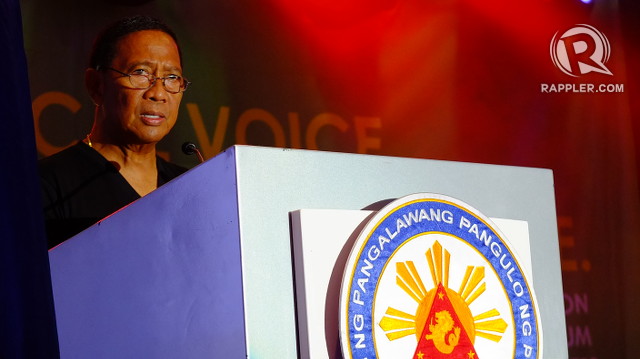SUMMARY
This is AI generated summarization, which may have errors. For context, always refer to the full article.
MANILA, Philippines – Each local government unit must formulate and implement its own climate change action plan.
This urgent call was made by Vice President Jejomar Binay on Tuesday, November 26, the second day of Climate Change Consciousness Week.
“In the strongest terms possible, I encourage and implore you to take full advantage of this opportunity. Learn as much as you can about how you can better prepare your community and our people against the ravages of nature that stand to grow fiercer in the coming years,” Binay said, addressing local government officials present at the event.
Local governments are at the frontline of devastating climate change impacts like typhoons, floods, storm surges, droughts and heatwaves. But the law empowers them to craft and implement measures to prepare them for the worst. (READ: 5 steps to disaster-ready, climate-resilient communities)
Under the National Climate Change Action Plan (NCCAP), LGUs are to be assisted in the creation of their Local Climate Change Action Plan. The plan should consist of policies and programs that allow the community to adapt to climate change. The measures should be cross-cutting, improving not only disaster response and preparedness but also adjusting agriculture, water systems, power supply, environment management, food production and health to climate change.
While the national government, through the Climate Change Commission, is mandated to assist LGUs in pursuing climate change adapation, LGUs should take the initiative to climate-proof their communities.
Survival fund
The P1-billion People’s Survival Fund is meant to be tapped by LGUs most in need of adaptation projects like coastal communities vulnerable to storm surge (extreme flooding caused by sudden sea level rise). But need is not the only criterion for selecting which LGUs get funding.
According to Climate Change Commission Assistant Secretary Joyceline Goco, LGUs have to prove they will make good use of the funds as well.
The LGU should show how serious they are in pursuing adaptation by crafting a project proposal which is then evaluated by the People’s Survival Fund board.
“The proposal should be science-based, it should have gone through a process of identification. It can’t be just because the LGU official wants it. There has to be a basis of need. We don’t want to waste the resources on a certain project for adaptation,” said Goco.
Going local
But localizing climate change resiliency is crucial if the country is to be better prepared for another Super Typhoon Yolanda (Haiyan), the off-the-charts typhoon that smashed into central Philippines on November 8 leaving more than 5,200 people dead.
While the NCCAP is a laudable project that illustrates in broad strokes the needed measures, local action plans ensure more concrete steps are taken.
They bring general terms like “adaptation” and “mitigation” down to earth by turning them into policies that actually reach the people – projects like moving coastal communities on higher ground or launching public health education campaigns to combat dengue, malaria, typhoid and other diseases made more common by climate change.
“It is vital that they be distilled to consider the intricacies and peculiarities of the various communities, if they are to be truly responsive and resilient,” said Binay.
The Climate Change Commission is currently implementing its Ecotown project with the aim of making all LGUs climate resilient and disaster-ready. (READ: San Vicente, Palawan: The rise of the ecotown)
There are 18 LGUs serving as pilot demonstration sites to test the effectiveness and feasibility of ecotowns. They include San Vicente in Palawan, Siargao Island in Surigao del Norte, Batanes, Eastern Samar towns and Upper Marikina River towns.
The project needs only President Benigno Aquino III to sign its Implementing Rules and Regulations before LGUs can start applying to become ecotowns. Goco said she has received word that the President will sign it soon. – Rappler.com
Add a comment
How does this make you feel?

There are no comments yet. Add your comment to start the conversation.